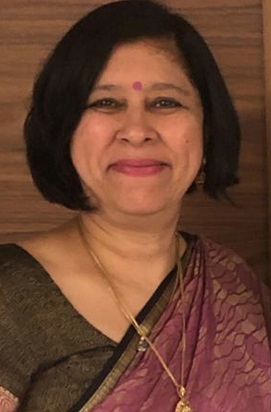
Women In Energy: Minaxi Garg
The Women in Energy series is a joint project between USEA and USAID that was developed out of USEA’s Engendering Utilities Partnership, a program funded by USAID to improve gender policies and gender outcomes at their respective organizations.

Every month we feature a woman who has shown exemplary leadership and showcase her story. The women among you come from diverse backgrounds and roles and bring a unique perspective to gender equality within the energy sector.
Minaxi Garg is the Chief General Manager at Power System Operation Corporation (POSOCO), in-charge of the Renewables Energy Sources, Corporate Planning, C&M Department at NLDC, Power System Operation Corporation (POSOCO) as well as Secretary, FOLD and Coordinator of the Integrated Management System. She is also responsible for capacity building of personnel in Load Dispatch Centers including State Load Dispatch Centers under Greening the Grid Project & Green Energy Corridor Schemes in areas related to increased penetration of renewable energy in the energy mix, RECs and Energy Saving Certificates Scheme.
Minaxi Garg graduated with an Electrical Engineering degree in 1983 from the Delhi College of Engineering, New Delhi. Her career spans stints with an architectural company, India’s Oil & Natural Gas Commission, National Thermal Power Corporation, Power Grid Corporation of India Ltd.(POWERGRID), and POSOCO.
Ms. Garg has been actively associated with the framing of Regulations and their implementation on the Indian Electricity Grid Code; Forecasting, Scheduling and Imbalance settlement of wind & solar; Power Markets; Inter State Open Access; Renewable Energy Certificates (RECs); provisions for variable renewable energy (vRE); Renewable Energy Management Centre; Deviation Settlement Mechanism; Ancillary Services, etc. and subsequent amendments, and also activities under Forum of Load Despatchers (FOLD).
*Neither USEA nor USAID alters the substance of the responses from the women featured. The answers are their own.
Women In Energy Interview Questions
1. How have your education and career path led you to where you are now?
Presently, I’m working in Power System Operation Corporation Ltd. (POSOCO) as Chief General Manager. Prior to that I have worked with Power Grid Corporation of India Ltd., National Thermal Power Corporation Ltd. (NTPC Ltd.) and Oil and Natural Gas Commission (now ONGC Ltd.).
I’d like to take this opportunity to pay tribute to my mother who, despite challenging circumstances, encouraged me to focus on my education and also to my teachers who believed in my abilities and potential. It’s because of these strong role models and mentors I had as a young girl that I developed an ambition and desire to be financially independent.
I consider myself fortunate to have received my education at a premier institution of India’s capital city of New Delhi, i.e. Lady Irwin Higher Secondary School and Delhi College of Engineering (DCE). Besides a formal education in Engineering, I also did a Management course and was awarded a Specialized Diploma in Management.
At the time of joining the engineering course, in my college, there were only five female engineering students in the entire college. My entering batch of 1979 in DCE had three times as many females. Although the sudden increase in female population was certainly a welcome change for the male students, there was still a long way to go. The subsequent years saw more influx of female students.
After graduation, upon joining a Central Public Sector Enterprise (CPSE) in the Oil Sector, and later switching to other CPSEs in the Power Sector, I was the only female in my department for many years. It had its own challenges including gender bias. Today, there is a huge improvement in the number of females working in technical fields but there is still much left to be desired. It is a pleasure to watch the confident millennials joining the workforce poised with grace, armed with technical skills and an enthusiasm to learn.
During the past 35 years of my career, various roles and responsibilities have been assigned to me and have led me to gain rich experience in Electricity Grid Operation, Electricity Markets including Renewable Energy Certificates & Energy Saving Certificates, Integration of Renewable Energy Sources, Energy Efficiency, Domestic and International Procurement, Human Resources (including my being a capacity building resource person), Disaster Management, ISO Certification, etc. I’m also Secretary of Forum of Load Dispatchers (i.e. System Operators) Secretariat which comprises of all System Operators of India. I’m a coordinator for activities related to Greening the Grid Project and Green Energy Corridor Scheme, presiding Chairperson of Internal Complaints Committee for prevention of sexual harassment at work, etc.
2. Over the course of your career, have you witnessed changes in the sector that have launched more women into leadership positions?
Yes, there has been a sea change in the attitude towards women. As a society, more women are joining the technical workforce. The increase in number of women participating in the sector has compelled leaders to design and tailor make women friendly work environments. This has facilitated women to balance work and life and be more on the frontline at work. Progressive policies like longer maternity leave of 6 months, paternity leave of 15 days to support spouse, sabbatical of up to 2 years for mothers with young children, have been introduced which were non-existent earlier. Policies also provide for study leave for higher education. Employees including women are nominated to leadership programs in premiere academic institutes in India and abroad.
3. Technology is transforming the traditional utility business model into a more modern interactive grid. Some utilities view this transformation as an opportunity to focus on change management and diversity. Research provides compelling evidence that inclusion and diversity unlock innovation and drives better business performance. What, if anything, is your organization doing to attract, retain, and promote more women into senior management positions to respond to the dramatic industry transformation?
POSOCO Power System Awards (PPSA) have been instituted in our organization to promote Research and Development in related fields by giving recognition and award to post graduate and PhD students. It is heartening to note that many women applicants have also received these awards. The system operator field being a unique and highly specialized one, our organization has entered into Industry academia collaborations. These steps provide exposure to students on the functioning of POSOCO and about the area of expertise required.
POSOCO has introduced progressive policies to make workplaces more women friendly. Women are being promoted to leadership/ senior management positions. POSOCO has a woman as one of the members of Board of Directors.
POSOCO has a very positive, safe and favorable work environment. Training/ capacity building programs related to operational requirement, competency, behavioral, management, prevention of sexual harassment, etc. have been devised and operationalized. Management advocates and demonstrates zero tolerance policy for sexual harassment related cases. Level playing field exists for women employees. Top Management believes in open door policy and is readily approachable to all employees.
4. Are talented women within your organization making it to top leadership positions? Why/why not?
Yes. Some of the facilitating factors include steps such as empowerment by top management, mentoring by seniors.
5. Companies that embrace diversity outperform their competitors. What type of diversity programs does your organization have in place to mentor future women leaders? How does your organization measure and report gender diversity? Is the data publicly available?
POSOCO has an internal system of preparing and reporting unit-wise gender diversity ratios. Our organization monitors the gender diversity within POSOCO and being a government company shares this information with stakeholders. The gender diversity percentage ratio of women is comparatively good compared to other Indian Central Public Sector Enterprises (CPSEs).
Further, the Government of India, recognizing the importance of gender diversity, has directed CPSEs to ensure level playing field for women employees.
6. What actions should the energy and electricity sector be focused on to accelerate change, increase diversity, and foster a better gender balance in the boardroom?
A number of factors play a role in gender imbalance existing in the sector, especially in the leadership role. The number of technically qualified women at the entry level in the organizations is very low. Despite having formal technical education from premier institutions and developing expertise in the energy sector, many women tend to drop out of the workforce after having children as they can’t afford a full- time job for the sake of raising their children and securing their good future. In this context, organizations must support policies that make motherhood and work compatible and are balanced. The job continuity of women in technical streams will definitely increase diversity and facilitate their entry in the Boardrooms.
Further, commitment of top management to achieve the goal of improving gender diversity can play an important role including implementation of creation of inclusive work culture, providing equal opportunities, overcoming counterproductive bias, empowerment, skill up-gradation, mentoring and career counselling of women workforce at all levels so as to improve their participation and contribution to the growth of the organization.

